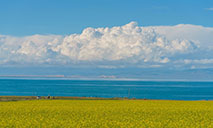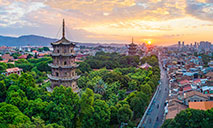Tibetan villagers in Nyingchi become prosperous through rural tourism
Galai village, a natural village located deep in the mountains in the southeastern part of the Tibet Autonomous Region, is famous for its beautiful peach blossoms in spring. However, in the past, the villagers haven’t always been aware of the importance of the ecological environment.

This is a peach blossom photographed in Galai Village, Nyingchi City on March 27, 2021. (Xinhua/Sun Ruibo)
“Before, we made a living by cutting down trees, which was not only detrimental to the environment, but also exposed ourselves to natural disasters such as landslides,” said Penpa, the head of the Party branch of Zinpa village, which administers Galai village in Nyingchi township, Nyingchi city, Tibet.
The village started holding peach blossom tourism and culture festivals in 2002, Penpa explained, revealing that so far this year, it has received more than 140,000 tourists, with ticket sales bringing in 4.2 million yuan.
In 2011, the village decided to develop the tourism sector collectively. Some villagers were selected to provide tourist services on behalf of the village, and before they started working, they received training at night schools so that they could provide better services. “The collective management has resulted in better travel experiences for tourists and greater fame for our products,” said Penpa.

On March 27, 2021, a girl admires peach blossoms in Galai Village, Nyingchi City. (Xinhua/Sun Ruibo)
Besides inviting farmers into the tourism industry, the collective management scheme has also significantly increased their incomes. Last year, the collective income of the village hit 10 million yuan, and the per capita disposable income was 31,300 yuan.
“There are six people in my family, and last year, we received more than 100,000 yuan in dividends from the peach blossom tourism and culture festival. This year, I plan to use my savings to build a new house and open a homestay business,” said a villager named Dawa Gyaltsen.
As beneficiaries of the beautiful environment, the villagers are now well aware of the importance of environmental protection. “We won’t pollute the environment while developing tourism. Each year, we plant at least 13.3 hectares of trees,” said Penpa.
Photos
Related Stories
Copyright © 2021 People's Daily Online. All Rights Reserved.










